THESIS COLLOQUIUM 2: Abstracts and Guest Critics PART ONE
Dec 10, 2022
Thesis students at the Azrieli School of Architecture & Urbanism presented in-progress work covering a broad range of topics, approaches, and themes at Colloquium 2, which took place from December 8 to 9 at the Architecture Building.
“The parameters for what constitutes an architecture thesis are wide, varying in format, content, and method,” says Associate Professor Lisa Moffitt, chair of the Master of Architecture program. “This breadth of possibility is one thing that makes the thesis experience remarkable.”
Scroll down to see abstracts and images.
During the colloquium, students presented their thesis projects, questions, and positions to fellow students, faculty, and five external guest critics. See profiles below. Students received supportive feedback on how to propel their work forward through the next semester.
Carleton University’s Master of Architecture thesis culminates the MArch degree and takes place over a full academic year. Milestones include three colloquia.
Guest Critics
Brigitte Desrochers is a member of the Research and Innovation team at Infrastructure Canada. Past professional roles include serving as Architecture Officer at the Canada Council for the Arts, where she administered the Governor General Awards in Architecture, Canada’s presence at the Venice Biennale in Architecture, and the Prix de Rome in Architecture.
She also worked in the Urban Architecture and Public Places section of the Department of Urbanism at the City of Montreal, where she contributed to the planning of the Rue de la Commune, Champs de Mars, Lachine Canal, Faubourg Saint-Laurent, and Cité Internationale district.
After graduating from the school of architecture at Université de Montréal, Desrochers completed a master’s degree and a doctorate at the Harvard Graduate School of Design. Postdoctoral research projects brought her to the British School at Rome, the Federal University of Rio de Janeiro, the Study Centre at the Canadian Centre for Architecture, and the National Gallery of Canada. Her work in photography, theory, and history has been exhibited and published in more than 30 venues, including the Municipal Art Society of New York and Architettura Arte Moderna Gallery in Rome.
Ipek Türeli is an associate professor of architecture and Canada Research Chair in Architectures of Spatial Justice at McGill University. Her research engages with spatial justice, urban media, and visual culture, and her books include Orienting Istanbul (co-edited, 2010) and Istanbul Open City (2018). Previously, she was an Andrew Mellon Postdoctoral Fellow at Brown University and an Aga Khan Postdoctoral Fellow at MIT.
Türeli received a PhD in Architecture from the University of California, Berkeley, a BArch (Mimar) from Istanbul Technical University, and the AA Diploma from the Architectural Association School of Architecture in London. Her work has been published in Traditional Dwellings and Settlements Review, History of Photography, European Journal of Turkish Studies, International Journal of Islamic Architecture, and Global Discourse.
A current book project explores early American campus landscapes and race outside the Americas. Her work has received support from the Graham Foundation, Middle East Research Grant, SSHRC, FRQSC, and CFI. She serves on the board of directors of the Society of Architectural Historians and the advisory council of the International Association for the Study of Traditional Environments. She is also the book review editor for the Journal of the Society of Architectural Historians.
Professor Anne Bordeleau is the incoming director of the Azrieli School of Architecture & Urbanism starting January 1, 2023. She joins the Azrieli School after 15 years at the school of architecture at the University of Waterloo Architecture, where she also served as O’Donovan Director since 2016.
Bordeleau is an architectural scholar and educator with a longstanding interest in many “invisible” facets of architecture, whether time, social interactions, voices that might have been silenced, a building’s past, or what lies in the shadow of a city’s monuments. Her publications include articles in the Journal of Architecture, Architectural Theory Review, Architectural History, Architecture MPS, Footprint, and Les Cahiers de Droit. In addition, she has written chapters in books, Materiality and Architecture, Chora 7, Architecture’s Appeal), and a monograph, Charles Robert Cockerell, Architect in Time: Reflections around Anachronistic Drawings.
Bordeleau co-authored the book and exhibition and oversaw the creation of plaster casts for The Evidence Room, displayed at the 2016 Venice Biennale in Architecture, the Royal Ontario Museum, and the Hirshhorn Museum. She is interested in architecture as a cultural act, a commitment that informs her research as much as her approach to education.
Carole Lévesque is head of the School of Design at UQAM and co-founder of the Bureau d’études de pratiques indisciplinées, which is interested in critical design processes. She is also a research member of the Centre Cultures-Arts Sociétés (CELAT), an inter-university centre that aims to shed light on processes of pluralization. Through her research-creation work, she explores the forms of representation of the urban territory, its temporalities and its uses, particularly in the abandoned spaces of the city.
Lévesque is the author of About Uselessness in Architecture (2011) and Finding Room in Beirut, Places of the Everyday (2019). She co-edited the book Inventories, Documentation as a Design Project (2021) and is currently co-editing a book on the drawing and construction of imaginary places.
She recently co-curated, with Thomas-Bernard Kenniff, the exhibition Drawing Conversations at UQAM’s Design Centre, which brought together the work of 16 architects and academics in an exchange on contemporary drawing practices in architecture. It focused on the capacity of drawing to engage reflection on modes of representation, design practices, and research fields and the role of this reflection in the construction of a common world.
Associating with Obsolete Objects
Student: John(HyeYoon) Ahn
Advisor(s): Natalia Escobar Castrillón
In modern days, it seems that we live in a more fictional reality than a sci-fi movie, where geopolitical tensions are leading to wars, contagious viruses sweeping the globe, and an increasing climatic crisis expedited by our unsustainable lifestyle and the elite’s systematic denial of climate change. As a result, we are reaching faster towards an end, or perhaps already in the final scenario of the Anthropocene. Yet we are becoming more paralyzed by the trouble we face.
The aftereffect of our unsustainable modernization has fragmented and entangled our history, memory, society, and environment, bringing moral and ethical issues such as inequality, alienation, and pollution. In this sense, our entangled reality of today is a direct consequence of a lack of companionship, stewardship, and responsibility of the past that we failed to address.
In my thesis, I intend to explore ways to associate ourselves in more meaningful ways with a non-human agency, specifically obsolete ‘objects,’ within a series of political and social injustices rendered through climate crisis. My methodology focuses on deconstructing materiality and phenomena of injustice on a deep time scale.
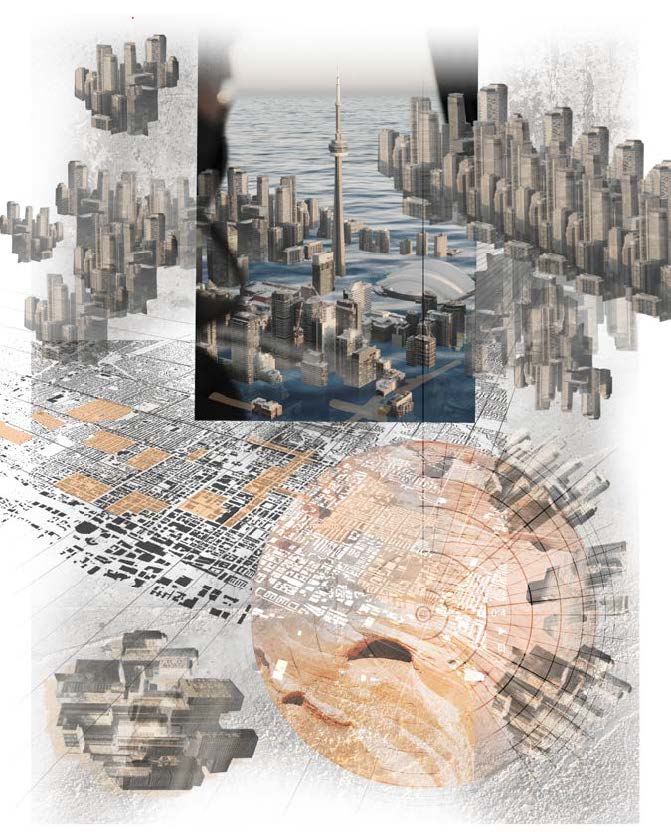
Ever-Expanding Toronto Condominium in Deep Time Scale
Periscope House
Student: Hadiya Al-Idrissi
Advisor(s): Catherine Bonier
Houses are the most intimate of building types. The notion of home evolves from the physicality of the house, creating an environment in the mind that turns mere living into dwelling. Because some of our most personal memories occur in a home, houses in turn should play a role in evoking moments of significance to their dwellers. With the mass-production of cookie-cutter housing, this thesis explores an alternative
approach. Can a single-family house be designed through an ethical and sensitive methodology? Can the designer balance the needs of their own parents with other factors?
The property to be examined is a vacant lot situated in their homeland of Mauritius, a site near the ocean. Because of its proximity to the beach, the site will test the materialization and interrelationship of memory, home, and water. This thesis navigates a personal and familial design process, simultaneously asking how one can inhabit the ocean within a home, safe from rising sea levels. The eponymous Periscope House becomes a metaphor for the memories that can be imbued within a home, far beyond what can be seen from it.
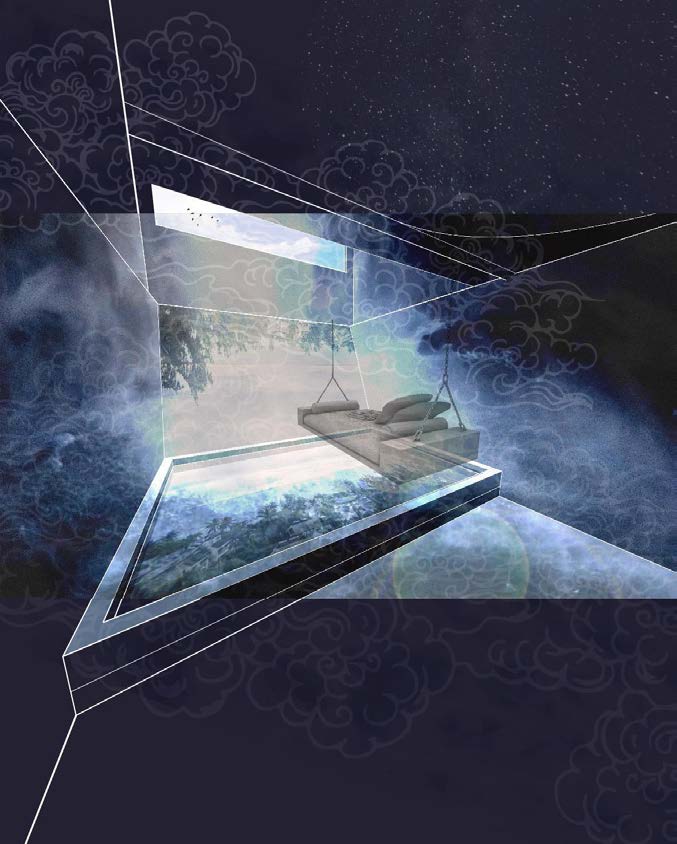
Initial Atmospheric Vignette – Digital Collage
Preparing for the “New World”:
Harvesting Ocean Plastics to 3D Print Islands for Areas Suffering from
Rising Sea Levels
Student: Corina Amarioarei
Advisor(s): Zachary Colbert
My Thesis focuses on the architectural potential of transforming ocean plastics into 3D printing islands. These islands, dubbed “The New World”, are deployed to areas suffering from land loss due to rising sea levels. The New World’s mission is not just sustainable, but regenerative. It is a land reclamation project that is designed to maximize the ecological opportunity for biodiversity, both above and below sea levels. The underwater structure will be designed to maximize the potential for coral growth and spawning grounds, whereas areas above the water will be designed for sea bird nesting and native vegetation growth. The ocean provides an abundance of natural resources to support human life on the plastic islands. Natural currents can create electricity, water can undergo a desalination process, fresh air is constantly available for air quality, and marine life acts as food. My thesis proposes a possible future where most of our land will be submerged, and humans adapt to life on plastic islands. The New World would be modular and can be combined with other plastic islands as expansion is needed. Although these islands are meant to be shipped all over the world, I will be focusing on the location of the Marshall Islands as my site.
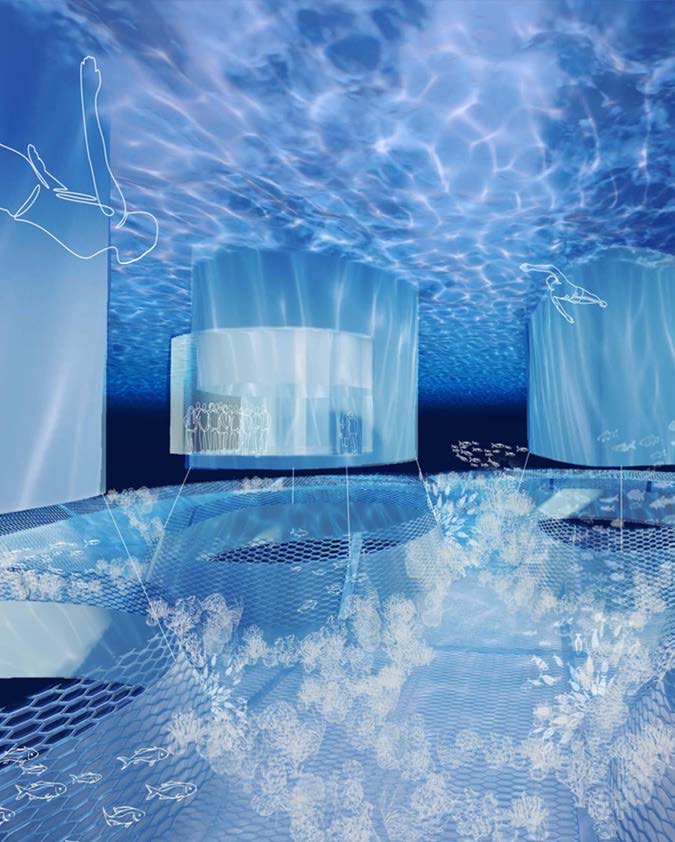
Sketch showing underside of islands and coral growing platform.
Reworking the Suburban Realm
Student: Matthew Beliak
Advisor(s): Jerry Hacker
This thesis explores the relationship between architecture/urban design and social connection in suburbia. Specifically, the question is whether suburban morphologies are contributing to country wide patterns of loneliness being observed? Previous work has not thoroughly addressed the role architecture and urban design plays on social connection in suburbia. The car has driven the morphology to date but with the emergence of ride sharing and self driving autonomous cars, the need to accommodate cars in suburbia could change, opening up new spaces and opportunities to promote social connection in suburbia. To date, I am using analytical mapping and ultimately use the methodology of research through design to test ideas I uncover. From this work I hope to show how existing suburban morphologies might evolve through design to become socially connected places.
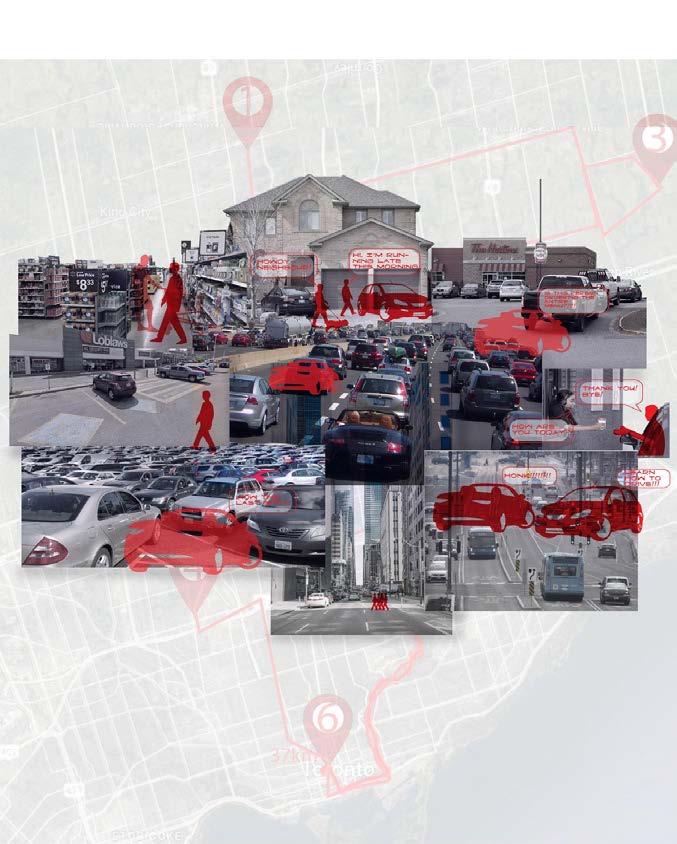
A day in the life of suburbia
From Material Production to Social Resilience:
Creating a New Life for Smiths Falls’ Former Water Treatment Plant
Student: Melissa Brady
Advisor(s): Mariana Esponda and Mario Santana Quintero
Once a vital aspect of Smith Falls’s service infrastructure, the Waterworks Buildings hold a layered and distinct past that reflects the history of colonialism in Ontario. From a privately owned gristmill to a pumping station to a water filtration plant, the complex has evolved overtime to meet the changing needs of the community. However, with the construction of a new modern water treatment facility nearby, the complex has been left abandoned since 2010 and has experienced significant deterioration.
This thesis explores using existing and new conservation practices to address the current conditions of the site and its heritage values. Design will be used to explore appropriate approaches to the adaptive reuse of the site. With the goal of adapting a place that was once a means of material production in a colonial past, to a means of social resilience in a more diverse and inclusive present and future.

Conceptual palimpsest for the adaptive reuse of the
Smiths Falls Water Treatment Plant
Adjacent Lives:
In-between Human Existence
Student: Stephanie Casanova
Advisor(s): Zachary Colbert
The climate realities we find ourselves currently facing, coupled with continuous urbanization have initiated an “evolution” across urban wildlife. Plants have begun to adapt to warming temperatures by blooming earlier. Non-human animals struggle to find sufficient food sources. Flooding destroys local habitats. Migratory habits and patterns are altered. There are innumerable spatial realities to which both
humans and their non-human neighbors must now adapt and given the immense role of the former in producing these effects, the moral and ethical responsibilities lie with them.
This thesis situates itself at the intersection of humans and non-humans, calling into question the anthropocentric design practices that not only exclude anything that is not human, but also greatly disadvantage them. With the intention of engaging underused spaces in urban environments, the alleyway serves as a catalyst to explore lifeforms in the city and envision their coalescence. Using the sense of sight, it interprets spatial experiences and creates a visual patchwork in the in-between. It forges new relationships and re-defines assumptions on who may be permitted to exist in space.

Exist and Belong: Through the eyes of a fly
Vessels as Thresholds
Student: Annette Chan
Advisor(s): Catherine Bonier
At the interface between air and water, land and sea, lies a watery threshold – a region ever-changing in form. How might the thresholds of Toronto Islands’ shores, ponds, and lagoons be occupied in new ways that balance the pragmatic need for stability with the desire to connect with dynamic watery experiences? Responding to residents’ desires for more opportunities to access and engage with the water, this thesis explores vessels as the thresholds to these water-based experiences.
Looking at water-sited architectural precedents, boats, and the reflexive transformation of plant and animal bodies, this thesis imagines the development of dynamic and tactile, reciprocal relationships between vessels and water. Balancing buoyancy, stability, and action in cycles of power and resistance, deployable, folded geometries are proposed to interact with fluid thresholds.
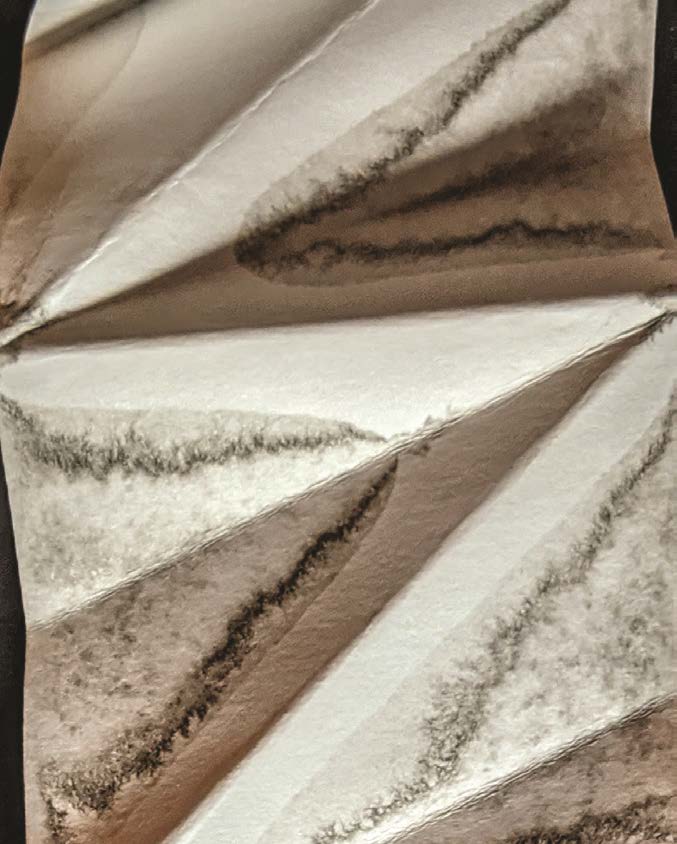
Tracking Fluid Thresholds
Still Growing Up:
Reframing Ageing in Architecture
Student: Sarah Chin
Advisor(s): Natalia Escobar Castrillón
Architectural research on ageing has been extensive and growing without significant consideration for individual ageing. There are a multitude of effects architecture, and the built environment have on the ageing population and their bodies. The perspective on ageing within the Canadian context being presented derives from first hand personal experience from listening to and observing seniors. The present understanding within architecture will be reframed on how to design with the ageing body in mind and what it means to age well in the city. The current focus is on supporting the residential scale of ageing in place and the various ageing bodies and the spaces they occupy. The analysis has come from research and drawing methods, supplemented by in-person volunteering experience to understand the current and future ageing bodies. The research shows that ageing is continuous, and that the existing architecture does not support the current and future senior population.
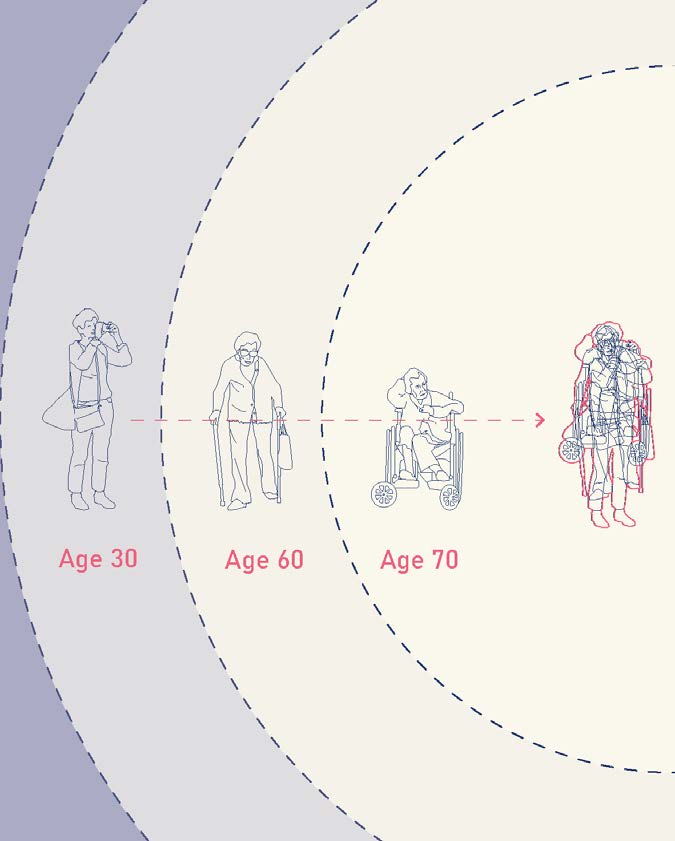
My grandmother’s house in Toronto has adapted and altered over time as her needs have changed with ageing.
Architectures of Care:
Understanding Community and Quality of Life in Guryong Village
Student: Jonathan Chung
Advisor(s): Jerry Hacker
Using Guryong village (a self-actualized community in Seoul, South Korea) as the site of investigation, this thesis explores the spatial relationships and architectures of care between the state and the city’s ignored and most vulnerable citizens. Recognizing the residents progress in self-creation and selfprovision, the question of interest is to what degree might architectural interventions further enhance community
and quality of life for those in the village? To date, Guryong village has been subject to debate over land ownership and development; however, this thesis endeavours to explore the role, active and creative users hold in defining architecture and the city, including how community emerges in selfactualized urbanism. Current research methodologies include literature and media reviews (including social media testimonials and self-described videos), analytical drawing, and research through design. At this point in the process the thesis is considering introducing a series of speculative urban interventions to aid in furthering the agency and community of the residents of Guryong village. Using architecture’s potential to create broader citizen and urban dialogue, I hope this work will help build a better understanding of the value of self-actualized spaces and their communities.
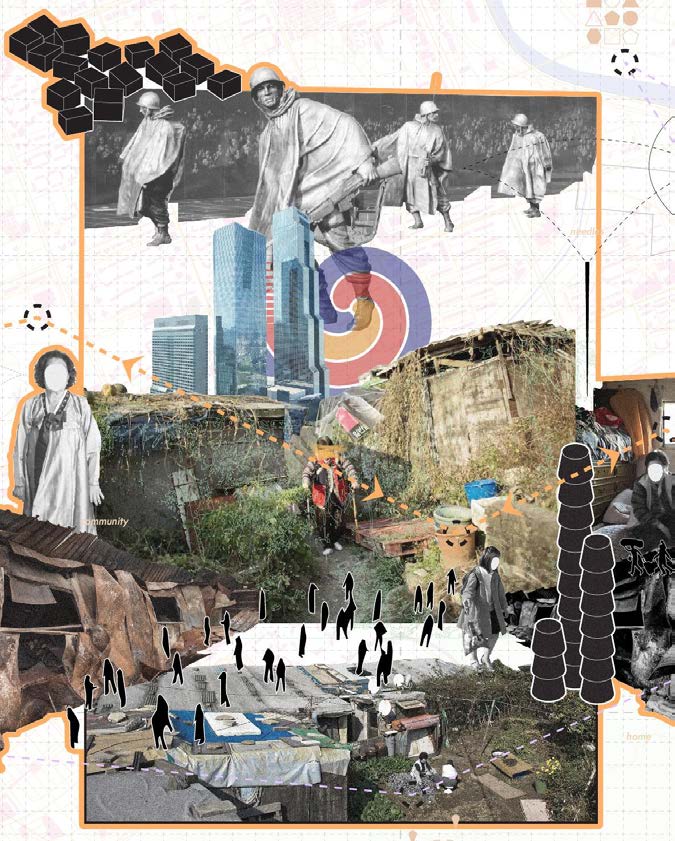
The story, state, and people of Guryong village – an exploration of community and quality of life.
Memory of the Land:
Discovering Landscape and History in a Cut in the Ground, Experienced through the Language of Making
Student: Shirley Chung
Advisor(s): Inderbir Riar
The plot of land that is now called Tunney’s Pasture has an abundant and varied history. Its rich Indigenous history animates the site and lives as memory in the land. The first western settlement of the site was in 1801 when it was granted to a daughter of a loyalist settler. The land subsequently changed hands a few times and in 1874, it was sold to a group of lumber merchants with an employee named Anthony Tunney whose responsibilities included pasturing the land with cows and horses. In 1920, a trench was cut through the land to help with spring drainage of the surrounding area. Later on, the land was home to an abattoir, an axe factory, and a failed subdivision. During the Great Depression and after World War II, its northern edge became a shanty town for the displaced. In 1947, the land was expropriated by the federal government to build Ottawa’s largest government complex.
The thesis seeks to explore a prototype of a place that captures its historical memories as well as serving as a place of making and discovery. It seeks to explore a relationship between the memories embedded in the site experienced through a cut in the ground and
how the language of material studies discovered through making can influence the architecture in creating a space of memory for the community.
Can the notion of a cut through the land be a way of experiencing the landscape and its history? Can the language discovered from graphic and material studies of making – screen printing, casting – be translated into material and texture and become architectural form? Can the relationship of the cut in the ground, the capturing of history, and the influence of material studies inform a place of discovering the forgotten histories of a site and serve as a model for other forgotten site histories around Ottawa?

Site model: a cut in the ground, history and material studies for a municipal archive.
Ecological Connections:
Exploring the Relationships of Landscape Protection and Human Interaction in Rouge Urban National Park
Student: Megan Combaluzier
Advisor(s): Lisa Moffitt
Nestled within urban sprawl and farmland, Rouge National Urban Park (RNUP) is the amalgamation of rich biodiversity, social activism, tourism and altered landscapes. Conserving natural environments are crucial not only for ecological resilience, but also for human health, livelihood, and experience. Accessible by over 20% of the Canadian population, the influence of RNUP stretches beyond its boundary. During a period of management change, increased anthropogenic stresses and conservation pressures, this thesis will explore the human aspect of a highly human influenced natural landscape. Humans are not just visitors but are instead inseparably part of the landscape.
Guided by ecological conservation, human experience, and current Parks Canada management policies, the thesis proposes to use the Rouge National Urban Park to reinterpret ideas of a ‘visitor centre,’ and what it means to visit a place. Ultimately, this thesis will use design interventions to find a balance between human influences and ecological preservation, and to find new ways of discovering a natural environment.
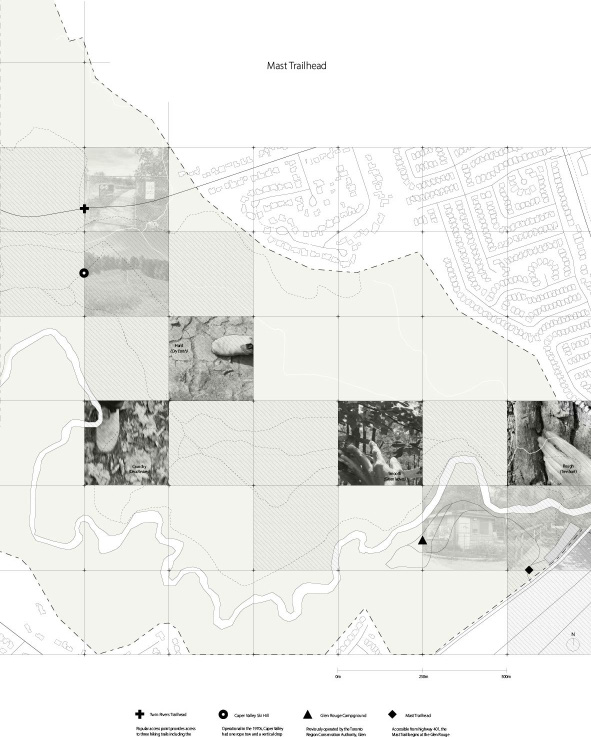
Map of Mast Trailhead in Rouge National Urban Park overlayed with images from a site visit
Knowledge through Awareness:
Towards Supportive Housing in Ottawa’s Byward Market
Student: Mathieu Denis
Advisor(s):Suzanne Harris-Brandts
In 2014, the City of Ottawa adopted a 10-Year Housing and Homelessness Plan that committed to ending chronic homelessness by 2024. Despite these efforts, the waiting list for social housing has expanded dramatically, leaving many still reliant on shelters. Factors such as a noisy environment, lack of physical and psychological support, and inferior living conditions in old buildings have led to many people living in inadequate shelter conditions. This thesis explores issues of homelessness in Ottawa’s Byward Market and proposes a one block redevelopment adjacent to the existing Shepherds of Good Hope shelter to address such issues. The historic connection of Ottawa’s Byward Market with urban density and social amenities lends itself well to fostering a strong sense of community. Building on the notion that presence prompts awareness, the work argues that an architecture that promotes social interaction between community members and those experiencing homelessness benefits all. Through on-site documentation and interviews with both clients and staff, the thesis first demonstrates the importance of design knowledge being acquired through designer presence. Then, a design proposal examines the opportunities for a multi-building inclusive campus site—one providing residential, social support, and community spaces while being conscious of its historical, environmental, psychological, and economic impacts. Overall, the work aims to raise awareness on homelessness in Ottawa and to provide innovative design strategies that invite discussion on the importance of architecture in providing spaces better adapted for communities.
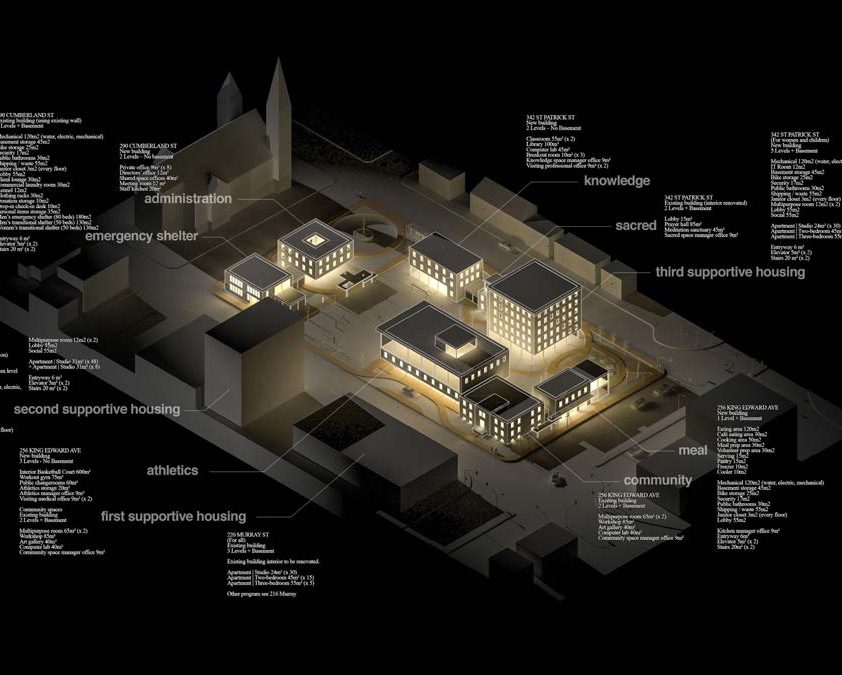
Campus program
Architecture of the Mosh Pit:
Metal Music to Open the Urban Fabric
Student: Miriam Doyle
Advisor(s): Janine Debanne
Following late capitalism’s market trends, fringe populations have largely disappeared from North American urban centers. Ottawa is no exception. Decision makers and urban planners have long prioritized condominium and office developments in Ottawa, and homogenized its urban fabric. This thesis utilizes metal music as a catalytic tool to pierce and disrupt normative planning in Canada’s capital. A metaphorical structure, metal inspires unconventional urban strategies, and triggers architectural thoughts focusing on marginal dwellers.
An urban edge where downtown Ottawa’s southern limit collides with a 400 series Ontario highway offers an ideal site to reflect on disruption and marginality. Due to their adjacency with Highway 417, the lots at 280 and 288 Catherine Street are not luxury development material. An exclusive housing development will soon rise across the street, replacing what was once the very inclusive Ottawa Bus Station. In its search for an architecture of community and inclusion, this thesis sees the “undesirable” location as a key condition for non-conformist and undermarket urbanism and
architecture.
While at first glance metal’s aesthetics and sonic characteristics may seem menacing and dark, these operate according to mechanisms of catharsis, shared embodied experiences, and acceptance. The crashing brutality of metal’s sounds and rituals effect healing, grounding, and sense of belonging. How then might architecture take advantage of metal music and culture to support marginal communities and their rituals within city cores? Metal music, its concert rituals and practices, community aesthetics and vivid associated nomenclature, all are strongly embodied and suggestive of an architectural language. This thesis examines disruption as organizing principle. A new set of urban gestures, spatial ideas, and architectural languages, here aim to resist market forces in Ottawa’s core and anchor access to the city and individual expression.
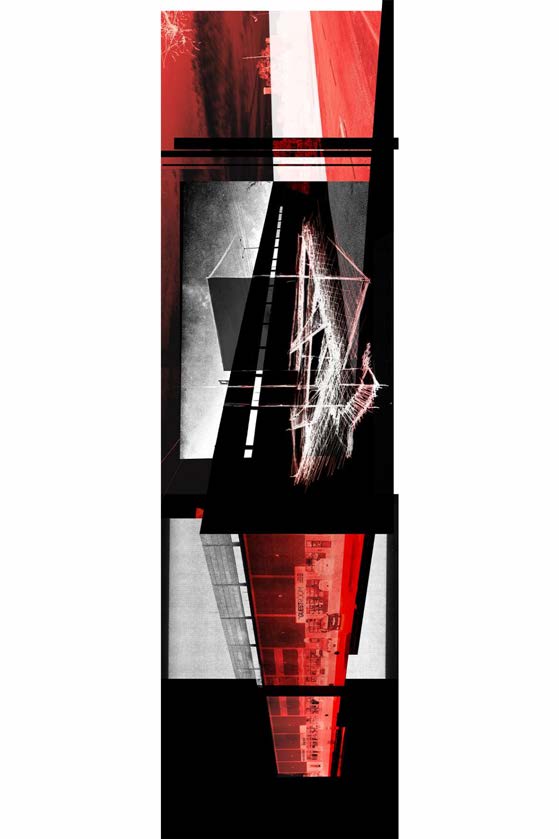
Mosh pit architecture
Caught in the Heart of Vanier:
Envisioning Public Housing Underutilized Urban Spaces
Student: Joshua Eckert
Advisor(s): Ben Gianni
One of the largest challenges when creating subsidised housing in Canada is accessing affordable land in a central location with access to social services, transportation networks, schools, and essential businesses. This obstacle creates a system where low-income and subsidised housing is often isolated within a city, creating an ongoing cycle of poverty until the neighborhood demolished or gentrified. As the buildings are decommissioned the existing community becomes displaced from their social services, communities, sources of income, and houses which they can afford.
The fist goal of this research is to locate land within a built community that can sustain social housing. The second is to design public housing within that community before the cycle of gentrification pushes the community away from their networks and their homes. In order to combat the costs of construction the housing should be built on land already in the public realm and should be capable of contributing back to the surrounding community to prevent and disassemble the stereotypes of subsidised housing. The site that has been located is an underutilized park in the heart of Vanier that is contained on all sides by houses, schools, and abandoned structures. The intent of this research will be a showcase of how we can use underutilized parks within our cities to both create more subsidised housing as well as keep our public spaces occupied, full of life and culture, and safe.
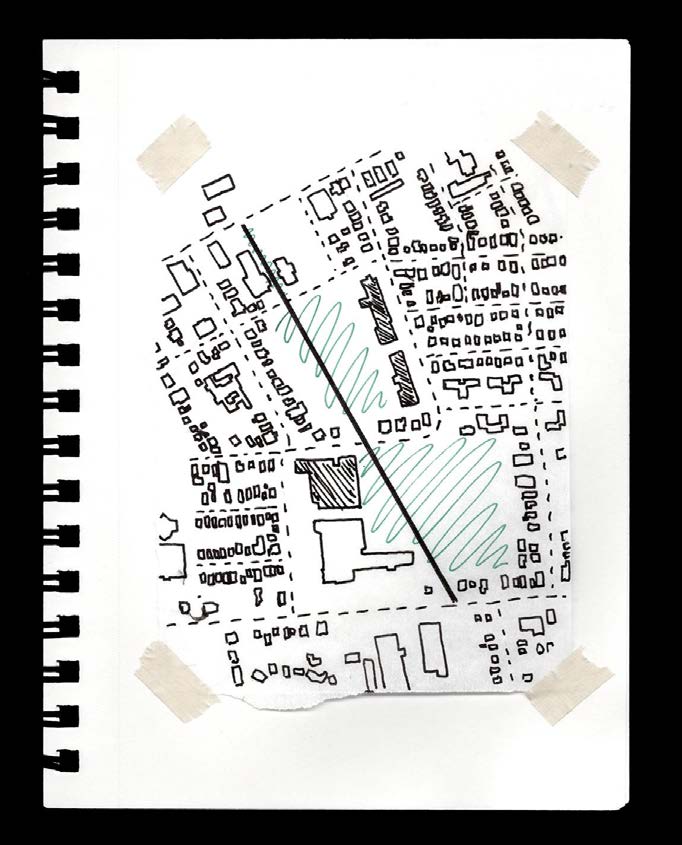
The parks caught between Montreal St. and McArthur Ave.
The heart of Vanier.
An Alternative City:
Tracing Mental Health Consequences Across Ottawa’s Urban Fabric
Student: Emily Eikeland
Advisor(s): Federica Goffi
Ottawa’s urban realm fosters many devices of isolation in various forms throughout its landscape, in turn contributing to a society that is more disconnected than ever. Research has found these conditions of social isolation between urban residents to negatively effect one’s mental health and wellbeing, however cities still lack consideration for the quality and quantity of their social spaces. Due to rising trends of living alone, greater demand is placed on open public space such as plazas, squares, and streets to become the collective backyard of urban residents as a means to keep the city well connected. Yet, the negligence of city officials to accommodate human needs in its downtown public core have resulted in its open spaces remaining empty and unused. This thesis critiques Ottawa’s neglect of open public space, while proposing a network of interventions that reimagine how existing plazas in downtown Ottawa can be revitalized to promote human connection and mental health.
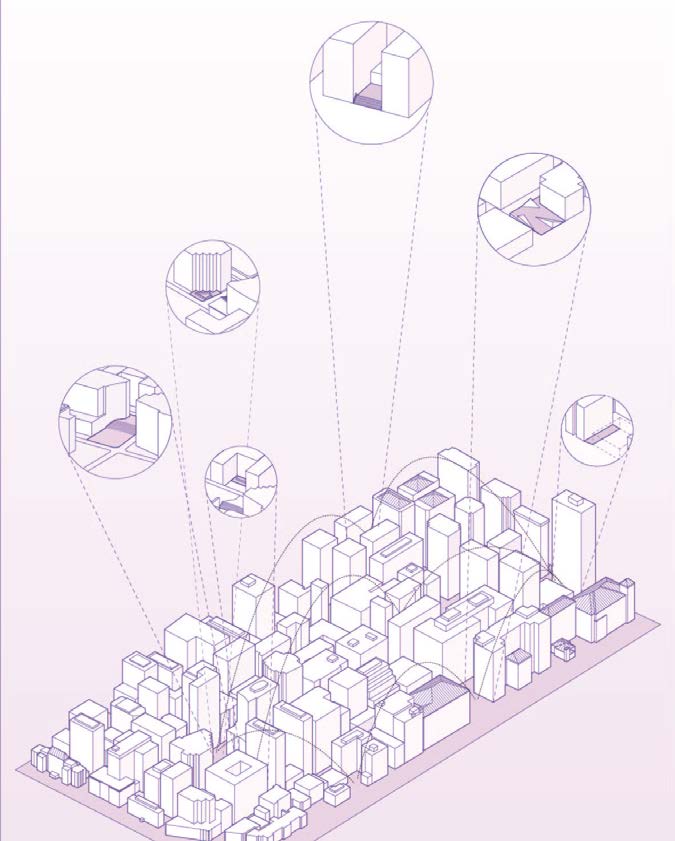
Axo drawing highlighting a proposed public network throughout Ottawa’s financial district
Building Hope:
The Forgotten People of Gaza
Student: Sarah Fahmy
Advisor(s): Suzanne Harris-Brandts
Since 2007, the Palestinian territory recognized as the Gaza Strip has been under an Israeli and Egyptian siege. Terrestrial, nautical, and aerial blockades, in addition to incessant onslaughts of militaristic attacks by the Israeli Defense Forces (IDF) have had significant impacts on Gazan infrastructure and ecology. This has resulted in limited resources, utilities, services and produced an urgency for intervention.
This thesis aims to ameliorate the conditions in the Gaza Strip to provide empowerment and agency while building hope for the people of Gaza. Through spatial mapping of historical patterns, cataloguing of photographs, and examination of existing revitalization efforts, the thesis unpacks the current challenges facing the Gaza Strip and proposes designs that move beyond mere sustenance to interrupt the cycle of oppression.
The design proposal expands on current UNDP revitalization efforts located along the drying water channel of Wadi Gaza, to put forward a combination of transient and permanent hydro-electric and social pavilions. The work aims to provide a new model of stable utilities and service provisions while simultaneously providing social spaces of refuge.

Crafting with Earth:
Prospecting the Materiality of Clay through Making, Sensing and Thinking Ceramic Wall Tiles
Student: Ju Huang
Advisor(s): Sheryl Boyle
Diggings in the garden bed on the lower level of the School of Architecture building exposed the layers of dirt accumulated on this humble patch of soil. The garden is filled with dirt of untraceable origins. Nonetheless, it is not a blank canvas. It is a deposit of accumulated dust from over 50 years of activities at the school. Plants there have sequestered carbon from the air, grew and returned to the ground year after year. Student projects and events have been working into its folds and years of rain and snow have instilled the school’s spirit into this soil. It is the vernacular earth of the school.
My project dives into the materiality of this earth and explores architectural design through an empirical and iterative process of making, feeling, and thinking. My process is a sensory and poetic indulgence disguised as a scientific experiment. Touching, levitating, forming, and firing unearth the loam’s plastic possibilities and metamorphic characteristic, and reveal the feeling of soil and its potential to the hand and the heart, through the crafts of ceramics and printing, the soil vitrifies as a slice of time becoming a 10cmx10cm interior wall tiles. This vernacular artifact seeks ways to participate with the building.
The tiles will become an installation that engages in a dialogue with the layers of interventions in the school. The building’s patina, composition and proportions inform the various properties and contexture of the mosaic of these wall tiles. The tiles are not only an accumulation and concentration of dust of the past. The tiles do not embellish or cover, but to rather they reveal the narratives of the site, and provide visual, tactile, and acoustic nuances through their wonderous textures, colors and form, creating a unique, tectonic vernacular language.
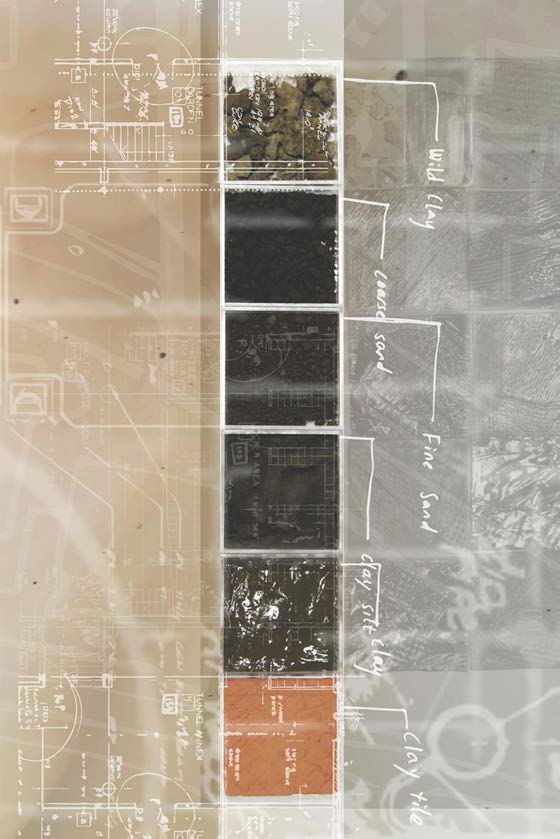
Neurodiverse Architecture:
Reframing Early Childhood Learning Spaces
Student: Argel Javier
Advisor(s): Federica Goffi
According to the Neurodiversity Paradigm, there are no good or bad brains, and no one type of brain is the right kind. People have different cognitive styles, and it is natural and healthy that people think differently. Neurodivergent people require acceptance, tolerance, and accommodations rather than seeking treatments that aim to make them appear neurotypical or attempt to make them forget their cognitive differences. This thesis examines neurodiverse architecture with an emphasis on early childhood learning spaces for preschoolers. It will explore four categories of early childhood learning spaces: Analytical, Language, Sensorial, and Cultural. By carefully examining these four different learning typologies, we may better understand how children can develop abilities like problem-solving, communication, motor skills, and social development. Developing these skills early is crucial in the growth of children, especially for neurodiverse children who have autism. Analyzing these early childhood learning space typologies provides diverse situations, which can help children to discover what works best for them and see how their differences may be advantageous to everyone.
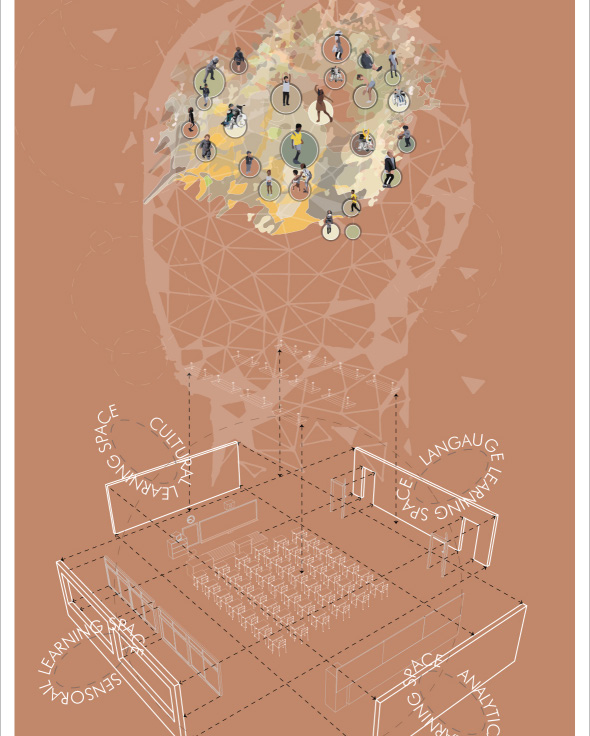
Dismantling conventional learning spaces to shift into more accepting and inclusive learning spaces for neurodiverse and neurotypical children
Las Vegas:
Vanishing Illusions of Paradise and Fantasies of Plenitude
Student: Kaleigh Jeffrey
Advisor(s): Piper Bernbaum
The city of Las Vegas continues to preserve and reinforce a narrative that hedges forward against reality. At the edge of the city where the urban environment meets its surroundings, there is a noticeable friction between the human infrastructure and the landscape it scrapes away from. As we continue to grapple with the rapid environmental change we face in the anthropocene, the instability of this contrast is becoming more evident. Years of urbanization and constant drought, made worse by a warming climate, have contributed to the rapid decrease in water levels of Lake Mead. In response to this, new laws and mandates are being implemented, working to remove all decorative grass, cap the size of swimming pools, eliminate water features and hammer down on water wasters. The city of fantasy is being challenged and its image along with it.
This thesis investigates the future of the city as it negotiates the conditions of the changing desert through speculative design work and climate fiction. Using the city’s new climate action laws and existing spatial tools as a guideline, five sites of both built and symbolic contesting binaries have been selected to explore what the role of maintenance is in architecture, and to what degree is it worthwhile. The sites and their tensions are being explored through mapping, field work, narrative and collage design work, expressing the high contrast and required maintenance needed to uphold the utopic/dystopic image of Vegas.
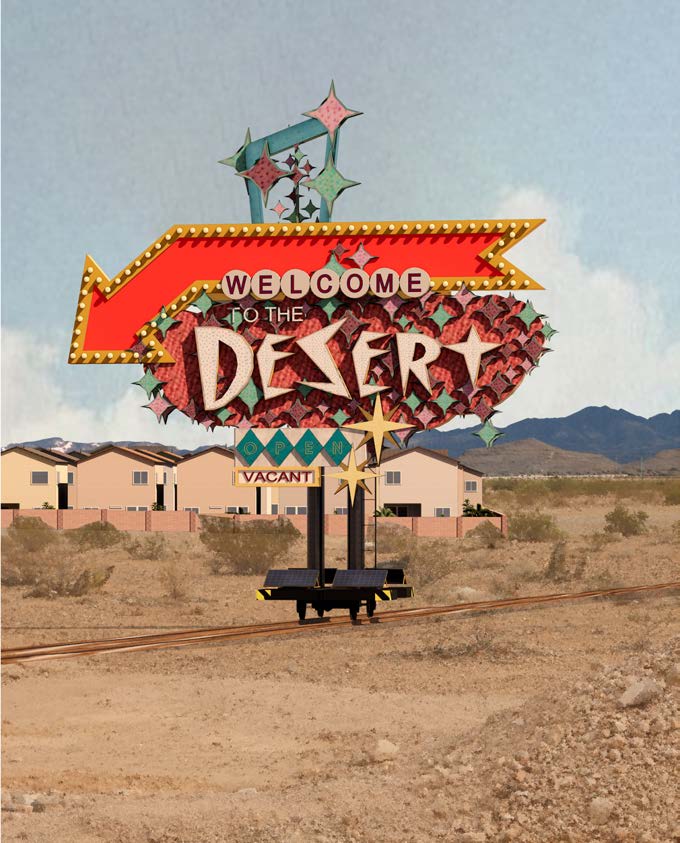
Narrative Exploration – Mobile Boundaries, illustrating existing and future tensions of Las Vegas
Mirror of Delirium:
The Other Anthropocene
Student: Howie Jiang
Advisor(s): Zachary Colbert
This thesis explores the Virtually Constructed Space narrating the inherent delirious nature of urban design and the architectural practice proceeding from the inevitable destructive future of the most dynamic, concurrent challenge – climate change, sea-level rise, and coastal development.
This thesis scopes in on the lack of collaborative mediums between scholarly work and the experiential nature of human perceptions. The intended outcome begins by examining the relationship between language, data, and narratives, versus human perception, visual agency, and virtual spatial construction. Although the objective may not be mathematically precise, the hypothesis encourages individuals to speculate about contextualized future, make informed yet creative choices, and assert personal voices in climate discussions of all levels.
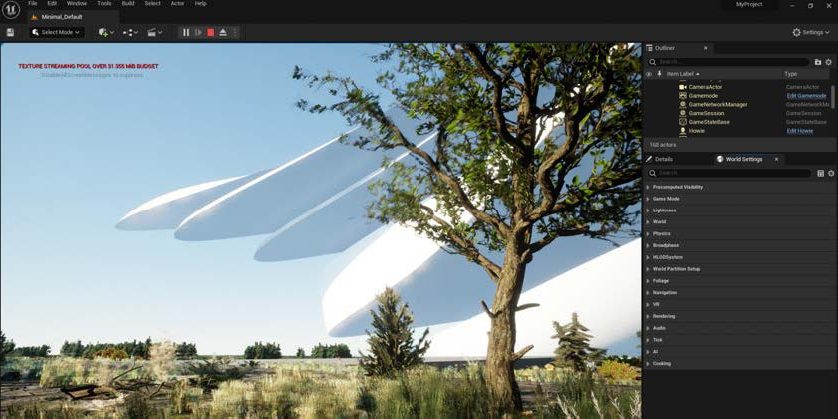
Virtual space construction, Richmond B.C., and control surfaces
The Resilient Nature of Inuit Knowledge:
Community, Culture and Climate Adaptation
Student: Natasha Lemire-Waite
Advisor(s): Jake Chakasim
This thesis explores the design of a refined building typology informed by Inuit ways of knowing, doing, and making with that of scientific (or westernized) knowledge. Anticipated is the idea of a ‘resilience center’ informed by the strength of both knowledge systems to support the needs of the community and promote food, energy, and water security.
Since the arrival of early Settlers across the north, including the imposition of their foreign assemblies and settlements, Euro-Canadians have displaced Inuit societies from their homelands and customary ways of life. Consequently, altering Inuit nomadic lifestyles and marginalizing their participation in a ‘foreign’ wage-based economy.
Amidst a myriad of social, cultural, economic, and ecological forces (or imperatives), today’s Inuit communities continue to find ways to balance ‘old’ and ‘new’ ways of life. By sustaining and strengthening Inuit culture in a rapidly changing landscape this thesis aims to explore an adequate infrastructure with supportive resources. Thus, a resilience center aims at ensuring the vitality of Inuit culture and identity remains intact and climatically adaptable, without further depleting the landscape they had survived on for centuries, which is deeply rooted in space, place and relational knowledge to the land and surrounding seas.
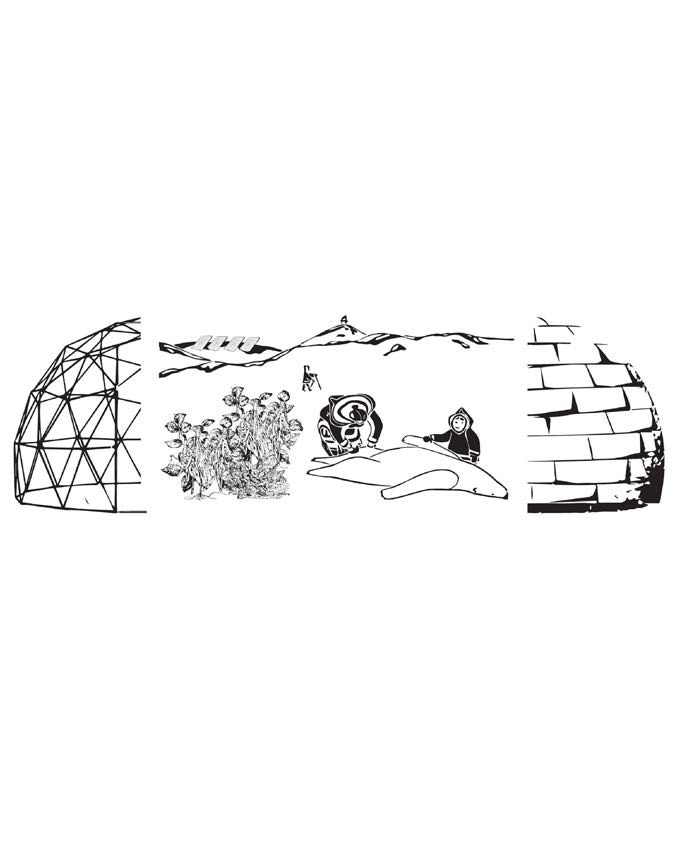
Preliminary Conceptual Idea of Braiding Knowledge in the Built Fabric